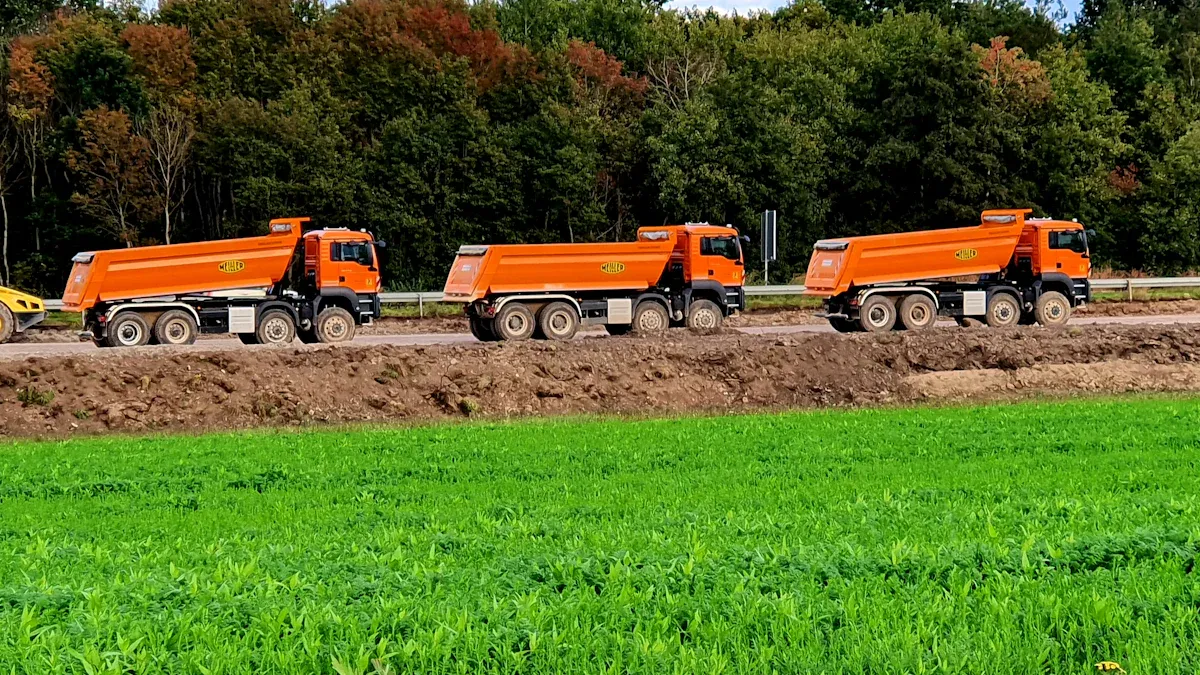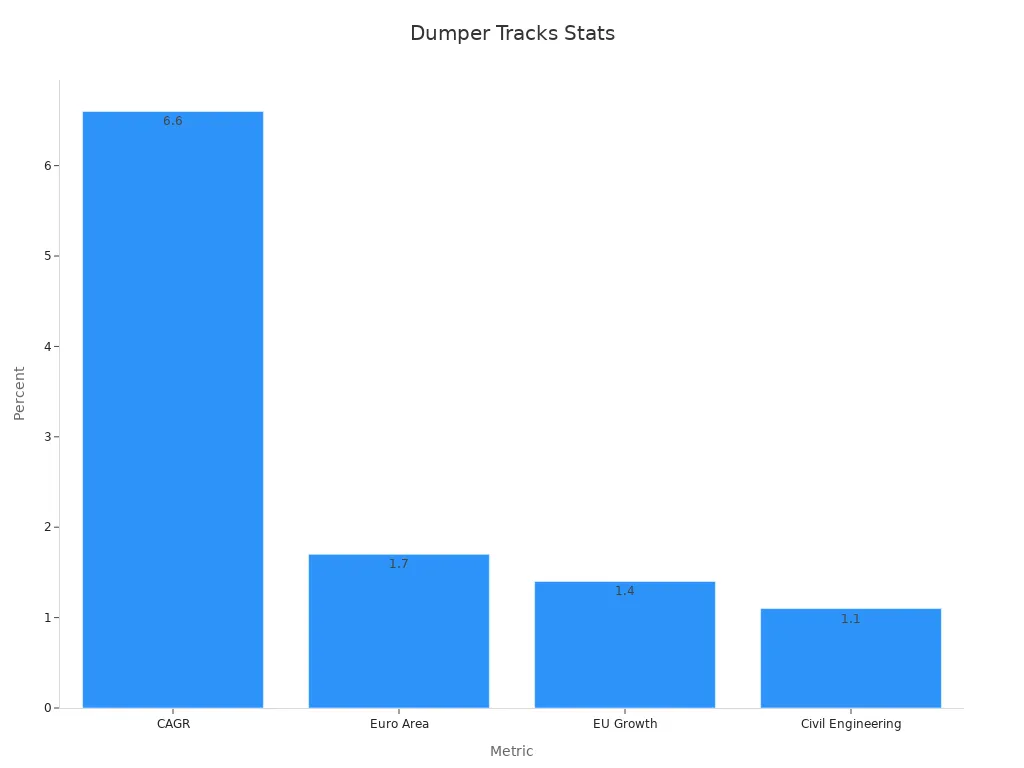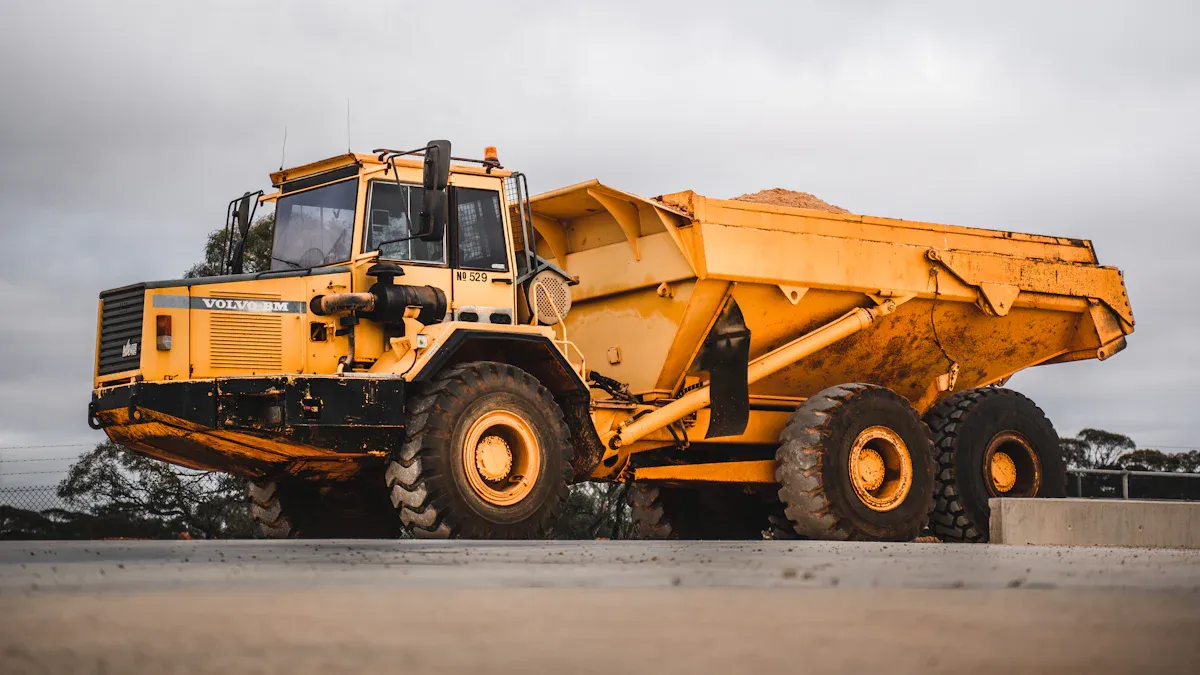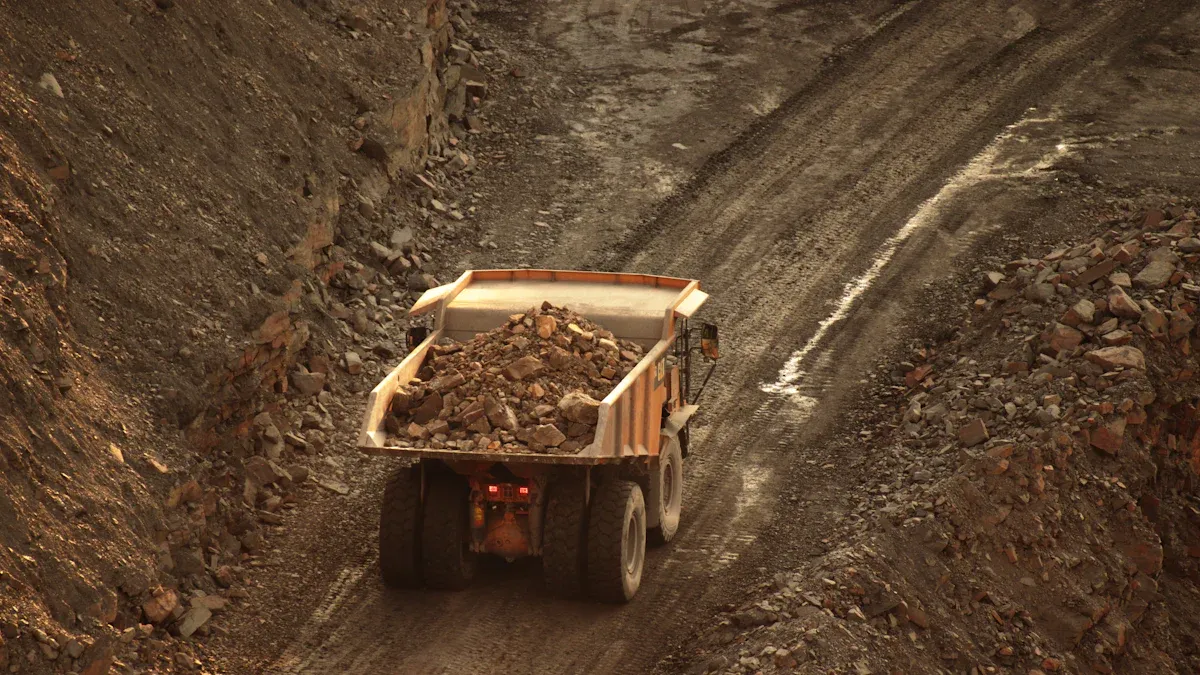Essential Tips for Picking the Best Dumper Tracks in 2025

Selecting the right dumper tracks in 2025 means better performance and safer worksites. Many companies see real gains from new track technology.
| Aspect | Details |
|---|---|
| Market Size (2022) | $20.2 billion |
| Projected Market Size (2032) | $33.5 billion |
| Operational Benefits | Lower maintenance, improved safety, more precision |
Key Takeaways
- Choose rubber tracks for smooth, quiet jobs and steel tracks for tough, rocky terrain to match your work needs.
- Check track size, tension, and alignment regularly to keep your dumper safe and running efficiently.
- Maintain and clean tracks daily, inspect for damage early, and pick reliable brands with good warranties for longer track life.
Key Factors for Choosing Dumper Tracks
Track Type: Rubber vs. Steel Dumper Tracks
Choosing between rubber and steel tracks is one of the first decisions for any operator. Rubber tracks work well for jobs that need less ground damage and more flexibility. They are quieter and help reduce vibration, which makes them a good choice for urban or sensitive environments. Steel tracks, on the other hand, offer more strength and last longer on rough, rocky terrain. They handle heavy loads and tough conditions better. Operators should think about the job site and the type of work before picking a track type.
Tip: Rubber tracks are often the best choice for construction sites with finished surfaces, while steel tracks shine in mining or demolition.
Material Quality and Rubber Composition
The quality of the material in dumper tracks affects how long they last and how well they perform. Tracks made with reinforced rubber compounds and embedded steel cords are stronger and more resilient. These tracks can handle tough jobs and resist wear. Fatigue analysis helps make sure the rubber can take on heavy stress over time. Some tracks go through tests in extreme heat, cold, and even underwater to check their durability. Good rubber tracks also reduce vibration, making the ride smoother and helping the machine last longer.
| Quality Metric / Analysis | Description / Impact |
|---|---|
| Reinforced rubber with steel cords | Increases strength and durability |
| Fatigue analysis | Confirms long-term performance under stress |
| Extreme environment simulation | Predicts how tracks last in harsh conditions |
| Vibration reduction | Makes operation smoother and reduces wear |
Tread Pattern and Traction Needs
Tread pattern plays a big role in how dumper tracks grip the ground. Some tracks use special designs, like H-shaped patterns, to give more biting edges. This means better traction on mud, gravel, or loose soil. For example, tracks with advanced tread patterns can provide up to 60% more grip than standard ones. Better traction helps the dumper move safely and reduces the risk of slipping. It also makes the ride more comfortable by cutting down on vibration.
Note: The right tread pattern can make a big difference in both safety and comfort, especially on tricky job sites.
Sizing and Dumper Compatibility
Getting the right size track is key for safety and performance. Tracks must fit the dumper model exactly. Many brands design their tracks to match specific machines, like Morooka, Yanmar, or Komatsu. This ensures the tracks can handle the weight and torque of the dumper. Operators should check track tension and alignment often. Proper tension keeps the track from slipping or wearing out too fast. Regular checks help the dumper run smoothly and avoid costly repairs.
- Make sure the track matches the dumper brand and model.
- Check track tension by measuring the sag between rollers.
- Adjust tension as needed to keep the fit just right.
- Inspect alignment to prevent uneven wear.

Recent studies show that the market for articulated dump trucks in Europe reached $1.3 billion in 2024. The market is growing fast, with a projected CAGR of 6.6% from 2025 to 2034. Construction output in the Euro area and EU also increased in June 2024, showing more demand for heavy equipment. New products, like all-electric dumpers, highlight advances in safety and cost-effectiveness.
A case study from Iran looked at a Komatsu 100-ton dump truck and found that preventive maintenance and understanding failure patterns are crucial. Another study in India showed that dump trucks use about 32% of total energy in mines. This means that choosing the right tracks can save fuel and improve efficiency.
Durability and Lifespan of Dumper Tracks

Assessing Build Quality and Construction
When looking at dumper tracks, build quality stands out as a top concern. Strong tracks last longer and help machines work better. Premium tracks use high-quality rubber with carbon black for extra strength. Many also have reinforced steel cords inside. These features keep the tracks from stretching and help them hold their shape, even under heavy loads.
Tests like the DIN abrasion test show how well tracks resist wear. Tracks with thicker treads and strong edges handle rough ground without breaking down fast. Good construction means less downtime and fewer replacements. Take a look at this table to see how long different tracks can last:
| Track Type | Lifespan (Hours) | Replacement Frequency (for 1,000 hours/year) |
|---|---|---|
| Standard Tracks | 500-800 | Every 6-9 months |
| Premium Tracks | 1,000-1,500+ | Every 12-18 months or longer |
Premium tracks almost double the lifespan of standard ones. This means less time spent changing tracks and more time working.
Manufacturer Reputation and Reliability
Choosing a trusted manufacturer makes a big difference. Some brands, like McLaren Industries, offer several grades of tracks and tread designs. Their premium tracks use special features, such as extra rubber and strong bonding between metal and rubber. These tracks often last longer and protect the machine’s undercarriage.
- Next Generation tracks use a Crack and Cut Quarantine System to stop damage from spreading.
- The Terrapin tread helps prevent rock damage and gives a smoother ride.
- Premium tracks from top brands can help projects finish up to 20% faster.
Reliable dumper tracks improve work speed and reduce the need for repairs. Picking a well-known brand gives peace of mind and better results on the job.
Maintenance Tips for Dumper Tracks
Maintaining Proper Track Tension
Proper track tension keeps dumper tracks running smoothly and helps them last longer. Operators adjust tension using a grease-filled track adjuster behind the front idler. Even a small change in sag, like half an inch, can change tension by thousands of pounds. Too much tension wears out pins, bushings, and sprockets. Too little tension causes the track to swing and can make the machine unstable. Operators should check track clearance daily. The best clearance is between 15 and 30 millimeters. Adjustments are made by adding or releasing grease. Safety comes first, so always park on level ground and wear protective gear during maintenance.
Tip: Use low speeds and avoid spinning the tracks. This reduces wear and keeps the machine in good shape.
Cleaning and Debris Management
Keeping dumper tracks clean helps prevent damage and saves money on repairs. After each use, operators should remove dirt, rocks, snow, and other debris from the tracks. This stops objects from getting stuck and causing wear. Clean tracks also help the machine use less fuel. Regular cleaning keeps the undercarriage in good condition and makes inspections easier.
- Remove debris after every job.
- Check for objects stuck in the rollers or sprockets.
- Store equipment away from direct sunlight to protect the rubber.
Regular Inspection and Early Issue Detection
Regular inspections catch problems before they become serious. Operators should look at the tracks, rollers, and other parts every day. Early detection of worn or damaged parts prevents breakdowns and costly repairs. Inspections also keep the machine safe and help avoid accidents. Experts say that regular checks improve productivity and extend the life of dumper tracks.
- Inspect all critical parts, including brakes and hydraulic systems.
- Replace damaged components right away.
- Keep a maintenance log to track issues and repairs.
Note: Regular inspections help companies save money and keep workers safe.
Selecting a Reliable Dumper Tracks Supplier

OEM vs. Aftermarket Dumper Tracks
Choosing between OEM and aftermarket dumper tracks can feel tricky. OEM stands for Original Equipment Manufacturer. These tracks come straight from the company that made the dumper. They fit perfectly and meet strict quality standards. Many operators trust OEM tracks because they know what to expect.
Aftermarket tracks come from other companies. Some offer great value and solid performance. Others may not last as long or fit as well. Operators should check reviews and ask for recommendations before buying. A good supplier will answer questions and help match the right track to the machine.
Tip: Always compare the specs and materials of both OEM and aftermarket options. This helps avoid surprises on the job site.
Warranty and Customer Support
A strong warranty shows that a supplier stands behind their product. For example, Prowler offers a 12-month warranty on premium grade rubber tracks for dumper carriers like the Huki 450. The warranty covers parts but not labor or damage from misuse. Buyers need to keep proof of purchase and may need to send photos if there is a problem. If a defect appears, the company may replace the part or offer credit toward a new one.
Customer support matters just as much as the warranty. Good suppliers answer questions quickly and help solve problems. They guide buyers through the claims process and offer advice on installation or maintenance. When picking a supplier, look for clear warranty terms and a helpful support team.
Summary Checklist for Dumper Tracks Selection
Choosing the right tracks for a dumper can feel overwhelming, but a simple checklist helps make the process easier. Here’s a step-by-step guide that covers the most important points:
- Measure track tension and adjust it to match the manufacturer’s recommended range. Incorrect tension can lead to faster wear and higher fuel use.
- Pick the narrowest track width that fits the machine. This helps the dumper move smoothly and reduces stress on parts.
- Think about how the dumper will work on slopes. Adjust the working direction on hills to balance out wear on rollers and sprockets.
- Check the alignment of the front idler, carrier rollers, and bottom rollers often. Good alignment keeps the tracks running straight and prevents early damage.
- Follow the right steps for installing and removing tracks. Use a pry bar if needed, and make sure the track followers sit correctly on the wheels.
- After installing, rotate the track to check for proper sag and tension. Adjust again if needed.
- Keep track tension at the right level every day. This helps prevent damage like lug cuts or separation.
- Inspect the tracks for signs of damage, such as cracks or corrosion. Store the dumper in a safe place and drive carefully to avoid problems.
Tip: Keeping a maintenance log helps track all adjustments and repairs. This makes it easier to spot patterns and plan for future needs.
Choosing the right dumper tracks takes careful thought. Every operator should look at their job site, machine, and budget. They can talk with experts for advice. Smart choices lead to better performance and savings over time. A little research now can make a big difference later.
FAQs
What is the best way to store dumper tracks when not in use?
Keep tracks in a cool, dry place. Avoid direct sunlight. Clean them first. This helps prevent cracking and keeps the rubber strong.
How often should operators check dumper track tension?
Operators should check track tension every day before use. Regular checks help prevent damage and keep the dumper running smoothly.
Can dumper tracks be repaired if damaged?
Small cuts or cracks can sometimes be fixed with repair kits. For bigger damage, it is safer to replace the track.
Media Contact
Company Name: Gator Track Co., Ltd.
Email: Send Email
Country: China
Website: https://www.gatortrack.com/


